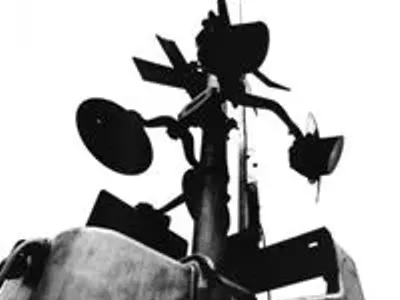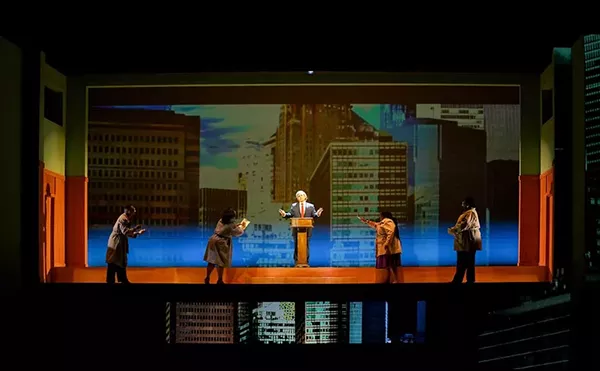
Audio By Carbonatix
[
{
"name": "GPT - Leaderboard - Inline - Content",
"component": "35519556",
"insertPoint": "5th",
"startingPoint": "3",
"requiredCountToDisplay": "3",
"maxInsertions": 100,
"adList": [
{
"adPreset": "LeaderboardInline"
}
]
}
]
The thirtysomethings are getting serious about the future, but not necessarily with babies and benefits. The urge to propagate and succeed among the anti-conformist crowd previously labeled lazy and unmotivated is translating, locally, into the establishment of means and mechanisms to provide security for creative endeavors.
Detroit artists are pooling resources in a practical and visionary approach to survival. Tired buildings are getting snatched up (at least what is still available and affordable) by those who have done their time as tenant and barmaid long enough and have found the desire and guts to commit to Detroit in a big way, as a place to create, rebuild, expand and call home. Venues erected by the struggling artist may help form a different city. These willful artists have the taste and education of the connoisseur, confident and discriminating yet supportive of other well-meaning contemporaries.
Private studios are abounding and some have become stable public resources for the fringe, such as Michigan Hot Glass, Salt-Mine Studio and any of the numerous nonprofits that seem to have popped up overnight.
Local musicians Joel Peterson and Scott Craig have embarked on the formation of a medium-size music, performance and workspace located on Grand River and I-94, to open within the next year. Badly needed, the venue is intended to host the best of local music and underappreciated national acts of every genre. They seek to offer people an arts-oriented locale “unencumbered by pool tables or rowdy drunks, the music being first and foremost and not the accessories to nightlifing,” according to Peterson.
Detroit artists are in desperate need of a higher quality middle ground, to fill the gap between the Detroit Institute of Arts’ Whistler exhibit and “here tonight gone tomorrow” art parties. Perhaps, like me, you have heard, “The DIA should be doing this show!” countless times. Sigh. It’s difficult to take this type of comment anywhere hopeful. Thus the few venues that provide exhibitions that are relevant and challenging are given too much responsibility. When they don’t live up to our ideal we turn into bitter codependents.
The reality is that those who fail to extricate themselves from the drama and stand up for something better perpetuate a tiny, insular and incestuous art scene. That said, progress toward a larger and more dynamic community appears to be on the horizon.
Shows such as Industrial Breakdown and 555 Gallery: A Cultural Outbreak, both held last month, provide us with immediate gratification, spaces where art exhibits within the white cube, raves of the ’80s and ’90s, decadent cuisine, new wave couture and gritty assemblage come together. Often these affairs focus on the renegade artist, or at least what is supposed to be renegade. Context is everything, as Marcel Duchamp proved in his notorious work “Fountain,” the urinal he “tagged” with the name “R. Mutt” and entered, somewhat scandalously, into a 1917 exhibition. Duchamp’s risks have done a lot for the avant-garde leanings of contemporary artists in search of the brilliance of juxtaposing things “out of context” and placing the rebel into the system.
With Industrial Breakdown, Linda Bannerton sought to encourage appreciation of “graffiti as an art form” and to dismiss the idea that all graf artists are vandals. The exhibit was formed to speak about the presence of abandoned buildings in Detroit as a source for art materials, artistic inspiration and as unrecognized venues.
The work in Bannerton’s exhibit seems to build upon the examples of its forefathers, consciously or not. The sculptor James Box, also a collector of local art, is undoubtedly aware of the reference he is making to an inaugural Duchamp piece (Bicycle Wheel, in which Duchamp connected a bike wheel atop a stool) with his assemblage of a bike wheel set atop an oil drum in the middle of a soiled chaise longue. Tim Caldwell’s work is typically surrealist and has the look of Hans Bellmer’s doll photographs from the 1930s — theatrical and fetishistic.
Sculptor Amanda Box appears to be trying to find her place and definition as an artist, capable of exploring a concept and bringing it to completion through metaphor and aesthetic principle. She has created new work specifically on the topic of abandoned buildings, giving a sentimental view in her piece Trumbull Mansions.
Jason Ellison contributes the most figurative, painterly and true-to-graffiti work in the exhibition. His instincts, commentary and innate talent are strong, and if he were to commit more time to making new work he could significantly contribute to the language of painting locally.
555 Gallery: A Cultural Outbreak, put together by Detroit By Design’s Rich Rice, was an evening abuzz with anticipation and life. Opening at 6 p.m., this glam slam was still hip-hopping with a diverse but arty crowd at 2 a.m. An anxious feeling of transition clung to the Ypsilanti space and its artists as all bid a hopeful sayonara to the time and place. (555 Gallery has plans to move to Detroit where its artists will rebuild their studios and exhibition space.)
Such events illustrate demand for more permanent venues and many, thankfully, are in the works. Supporting local and challenging art is indeed important. Within the past few years Detroit has morphed into a city where people actually complain of having too many really interesting things to do on a Friday night. We are almost overwhelmed by the surge of performance, visual art and multimedia events.
It will take some time for new endeavors to come to the surface. As the middle ground is built and developed, only the test of time will tell whether we can succeed.
Phaedra Robinson writes about art for Metro Times. E-mail letters@metrotimes.com.




